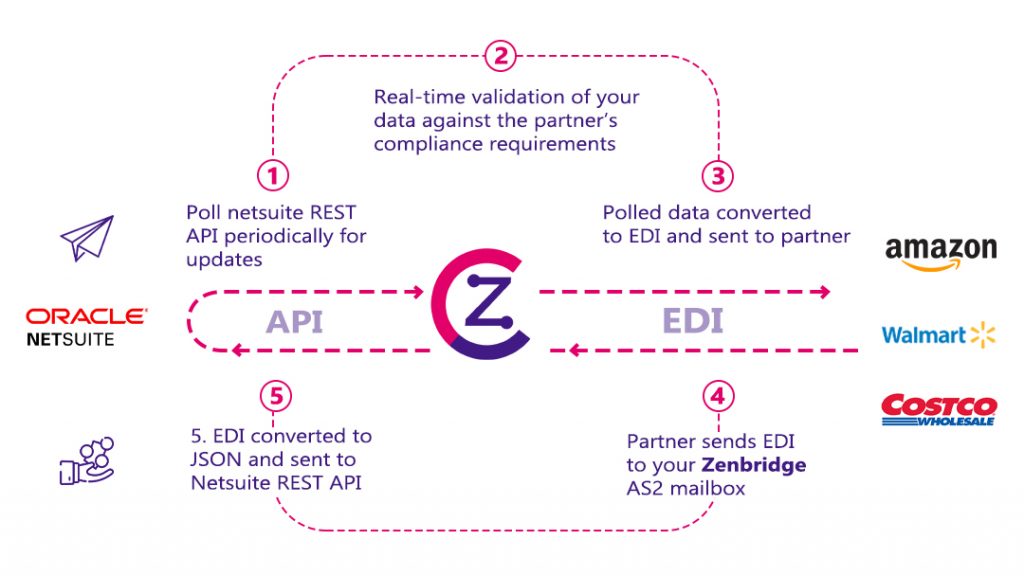NetSuite EDI Integration: A Complete Setup Guide for 2025

Introduction
Businesses growing in 2025 face pressure to simplify operations and keep pace with a fast-moving market. Oracle NetSuite ERP makes this easier with seamless EDI integration, using powerful tools like APIs and data mapping to directly handle orders, invoices, and shipments to accelerate cash flow and reducing errors. This unified business management suite streamlines your business process by combining financials, accounting, and CRM into one system. NetSuite ERP comes with an API, the ability to add custom fields, and the capability to set up custom triggers. This generally facilitates the creation of customized NetSuite EDI integrations.
NetSuite EDI Integration Options
NetSuite EDI integrations offer high levels of customization to align with the specific requirements of your trading partners across industries like retail, third-party logistics (3PL), and transportation. While NetSuite does not have built-in EDI capability, it easily connects with external EDI solutions or platforms using NetSuite SOAP and REST-based APIs – a widely adopted approach among NetSuite EDI partners. These integrations accelerate business processes like order processing or invoicing by automating business document exchanges, saving time and reducing errors.
NetSuite supports integration with EDI solutions through:
- SOAP (Simple Object Access Protocol)
- REST-based APIs
NetSuite REST API overview
NetSuite’s REST APIs are a powerful tool for integrating with EDI solutions and automating business processes like order management. They follow a structured design pattern to request or make an API call. Here are some important design features for developers:
- CRUD-Based Operations : The API supports to Create, Read, Update and Delete actions, enabling full management of records like sales orders or invoices.
- Uniform Resource Identifiers (URIs): REST APIs use URIs to access resources.
For Example: To fetch a sales order numbered 8689, a typical API URI might look like (snapshot)
- HATEOAS (Hypermedia): NetSuite’s APIs use Hypermedia as the Engine of Application State (HATEOAS), which distinguishes it from other network application architectures. With HATEOAS, you can interact with other network applications to fetch information dynamically through hypermedia.
Let’s say you’re fetching sales order data that in turn has sub-records like billing information, customer information, etc. Instead of giving the data in an expanded form, the API provides the URIs. You can use this URI to make another API call to fetch the billing information of the sales order.
NetSuite REST API Beta Features:
NetSuite also has some other APIs in the BETA phase, out of which there is one interesting feature called the transform API. It allows you to convert one record type into another, such as turning a sales order into an invoice or a purchase order into a business document like a bill. This simplifies workflows for integrating with trading partners across industries like Retail or 3PL.
Other APIs in the NetSuite Umbrella Beta Program include:
- Transfer Order: Manages inventory transfers between locations.
- Return Authorization: Handles customer returns and refunds.
- Assemble Item: Supports manufacturing or assembly processes.
- Vendor: Manages supplier data and interactions.
- Credit Memo: Processes credits for returns or adjustments.
- Inventory Count: Tracks stock levels for accuracy.
- Partner: Manages partner-related data.
NetSuite Tracking Events
Tracking events refers to the process of monitoring key actions such as the creation, transmission, and acknowledgment of business documents like orders, shipments, and invoices throughout the supply chain. In NetSuite and other enterprise systems, this helps businesses stay informed about the status of transactions with trading partners, ensuring accuracy, compliance, and operational efficiency. There are various methods to track events in NetSuite or other cloud-based ERPs:
- Webhooks:
A webhook is a way of invoking an API callback URI for a given event. For example, you can invoke a webhook when a new Purchase order is created inside your ERP system. So when a change happens inside your system you can notify/track the changes to the API URI defined in your webhook setting.
2. Polling:
Polling your NetSuite environment periodically may not be elegant but it works in some cases. It could be once every minute or every 30 minutes depending on your process and convenience.
3. Suite Script:
SuiteScript is NetSuite’s powerful alternative to webhook. They are JavaScript- based user event scripts that are executed on the NetSuite server. You can execute custom scripts on events such as create, load, update, copy, delete or submit. It supports most of the standard and custom records with exceptions in storing personal identification like a driver’s license or passport and other government- Issued IDs.
How to set up the NetSuite REST API?
There are three high-level steps to follow for setting up the NetSuite REST API:
- Create a role for REST API
- Create a Custom Integration Manager
- Create access tokens with the integration manager and role
Create a role for REST API
Create a role where you can define the specific permissions, and RESTrictions with different levels (View, edit, full, etc) for permissions. These permissions are applied to Transactions, (Bill, invoice, SO, PO, etc.) reports lists, setup, and custom records.
Create Custom Integration manager
The second step is to create an Integration manager. It defines how your application connects to NetSuite. While creating, you can decide whether you want to use a Token-based authentication system or an OAuth 2.0-based authentication system.
Create access tokens with the integration manager and role
Using the Role and the Integration manager you created from steps 1 and 2, generating an access token will give you a Token ID and Token secret. You will be using the token ID and the secret to make API calls. These credentials are used to authenticate API calls, enabling secure data exchange for business processes like order management.
How Zenbridge Can Help with NetSuite EDI Integration?
Zenbridge is a cloud-based EDI solution designed to send and receive data using API. It simplifies the process by allowing users to send data as API, which is then converted to EDI and forwarded to your NetSuite EDI partners. By converting business documents to and from API calls, Zenbridge eliminates the need for complex EDI expertise, making integration fast and cost-effective.
Zenbridge for NetSuite EDI Integration:
Steps for NetSuite EDI Integration with Zenbridge include:
- Sending EDI as API: Send API requests using webhooks, Polling , or SuiteScript for EDI transactions like purchase orders to Zenbridge. Zenbridge ensures compliance with trading partner’s requirements, such as retail or 3PL standards.
- Receiving EDI as API: Zenbridge converts incoming business documents (e.g., invoices, ASNs) from trading partners into JSON format and sends API requests to your NetSuite environment, automating data flow.

Zenbridge Features
Zenbridge’s platform is preloaded with APIs for all major US retailers, making it easier to connect with NetSuite EDI partners which offers features like:
- Pre-Built NetSuite Connectors: Zenbridge provides pre-configured connectors for NetSuite, enabling integration with major US retailers (e.g., Walmart, Amazon, Costco) and 3PLs in under three weeks. These connectors support all common EDI transaction sets and ensure 100% compliance with partner requirements.
- Real-Time Compliance Validation: Zenbridge validates EDI data in real-time, preventing non-compliant data from entering NetSuite and reducing chargebacks from trading partners. This ensures adherence to global standards like ANSI X12 and EDIFACT.
- API-to-EDI Conversion: Zenbridge converts NetSuite API requests into EDI formats (e.g., X12, EDIFACT) and vice versa, delivering JSON-based data to NetSuite for seamless processing. This eliminates the need for in-depth EDI expertise, allowing developers to use familiar API workflows.
- Webhook Support: Zenbridge enables webhook-based EDI integrations with NetSuite, allowing real-time event notifications (e.g., new sales order creation).
- End-to-End Automation: Zenbridge automates the entire order-to-cash and procure-to-pay cycles, including sales orders, invoices, ASNs, and inventory updates. This reduces manual effort, minimizes errors, and frees up resources for other tasks, enabling businesses to scale without additional overhead.
- Unparalleled Support: Zenbridge offers unlimited developer support, a dedicated delivery manager, and no charges until go-live, ensuring smooth onboarding. The platform proactively manages trading partner communication.
- Fastest Integration: Fast integration (under 2 weeks) with no setup fees and affordable pricing ($0.05/transaction, $200/integration).
Zenbridge helps companies with seamless NetSuite EDI integration, offering flexibility and ease in working with NetSuite EDI partners.
Who can use Zenbridge?
The Primary customers are:
- Retail brands:
Our platform is preloaded with API for EDI documents of all major US retailers. EDI integration with your retail partner is just an API call away.
- Transport and Logistics:
If your customers are expecting to be EDI Capability, you can use Zenbridge.
- ERP or custom Applications
Zenbridge has an extensive application that could be applied to multiple industries like supply chain, healthcare, etc.
Choosing an ERP like Oracle NetSuite, which comes equipped with APIs, is a strong indicator that your company is prepared for seamless integration and automation in the future. APIs enable organizations to become more proactive, transparent, and automated by facilitating smoother data exchange between systems.
Zenbridge’s API-driven platform ensures seamless, automated EDI transactions with NetSuite, enabling businesses to focus on growth without the complexity of traditional EDI infrastructure.